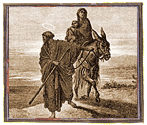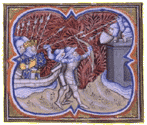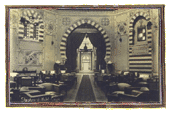 |
 |
 |
|
|||
|
Cairo: History's Crossroads The Egyptians are famous for their hospitality, a cultural tradition that dates back to Biblical times, when a traveling family from Bethlehem came looking for a room.

Legend has it that the Holy Family stayed a night or two in Cairo during their flight to Egypt. The fifth-century church of St. Sergius supposedly marks the spot where they took refuge. Sergius is one of many Christian pilgrimage sites in the city, a reason the Crusaders were so keen to get their hands on the Egyptian capital. Even though these Christian invaders were considered infidels, the Muslim caliph Al-Adid extended characteristic Egyptian hospitality to a party of knights negotiating Cairo's surrender in 1167. The medieval archbishop William of Tyre recorded the details of their reception in the magnificent Eastern Palace.

The palace is long gone. Today, the Khan al Khalili, Cairo's oldest bazaar, now stands in it's place. Though many a soldier has passed this way since the Crusaders' time, not all have received such royal treatment. Major T.K. Detroye, an officer in Napoleon's army during the French occupation of Cairo in 1798, couldn't wait to get back home.

A good way to avoid Cairo's squalor was to enjoy it from the river. In the mid-nineteenth century, traveling up the Nile in a lavishly outfitted dahabieh, an Egyptian houseboat, was the preferred method. Or so said nurse and hospital reformer Florence Nightengale, who made such a journey in the winter of 1849.
Visiting Egypt in Nightengale's day was often a do-it-yourself adventure that meant hiring your own guides, transportation, etc. Yet rapid developments in rail and sea travel around the turn of the century soon put the region within easy reach of Europe. Before long, a new character emerged on the shores of the Nile, the package tourist.

As Victorian-era English travel writer Amelia Edwards reported, the elegant Shepheard's Hotel was to the place to be and be seen when in Cairo.
A gas station now occupies the spot where Cairo's most prestigious hotel once stood, razed by a fire in 1952. Years later, Helnan, an international hotel chain, built a new Shepheard's overlooking the Nile. A lovely hotel in a beautiful location, but there's no recapturing the glory of the original. Still, in a city as rich in history as Cairo, the past is never very far away. In Cairo, I'm Tom Verde for The Savvy Traveler Thanks go to Kate Jennings, Simon Holt, Robert Da Pont, Kate MacCluggage and Catherine Drew for their help in this production.
|
 | American Public Media Home | Search | How to Listen ©2004 American Public Media | Terms of Use | Privacy Policy |
